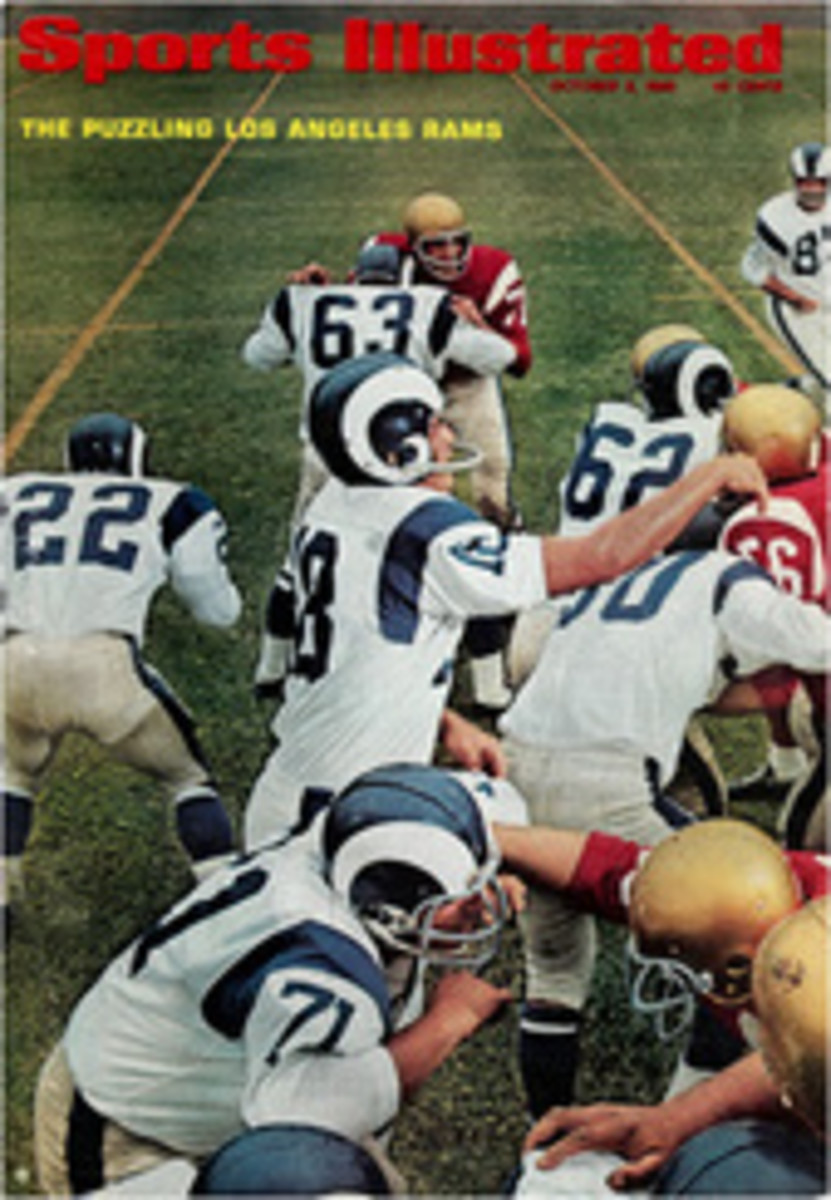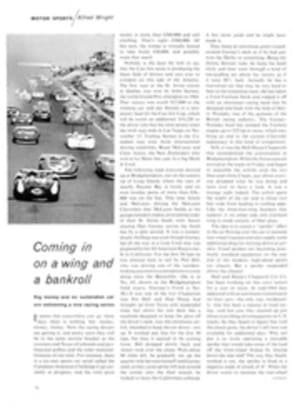
TWO HULLS MAKE TWICE AS MUCH WRECKAGE
The first so-called "world championship" for multihull sailboats of all kinds and classes was run off last week in the tailwinds of a northeast storm that had lashed Long Island for three whole days. In the big blow's wake, triple-hulled trimarans and two-hulled catamarans flew around New York's Little Neck Bay with the wild abandon of feathers in the blast of an electric fan. "Hey, look over there," shouted one spectator at this seaborne demolition derby as a big cat lifted her windward hull far beyond the capsize point while another seemed about ready to spear a porpoise with her sharp bows. But the man he was talking to had his eyes riveted on another spectacle, the like of which he had never witnessed. Off to starboard, one huge catamaran, unable to tolerate the situation any longer, had reared straight up on its hind legs and was slowly, wearily falling over on its back. "Never, never," said the appalled spectator, a man of some experience on the sea, "have I ever seen a sailboat tip over backwards before."
But there were other sights equally worth seeing. On the shore below the U.S. Merchant Marine Academy at Kings Point, a smaller cat's rig left the hull amid a shower of aluminum, Dacron and bits of stainless-steel wire. Another boat, hurtling along toward a wall of water, summarily stopped. She didn't capsize nor did she sink as sailboats are wont to do. She did what only cars and planes do—she crashed. The entire bay was littered with debris from other boats: bits of broken wing decks, tillers, rudders, lost centerboards. If nothing else, the first world multihull championships proved that, if boats with two and three hulls go faster than boats with one hull, they also come apart at the seams with even more alacrity.
Late September is about the only time in the sailing season when there is any kind of wind on western Long Island Sound, and wind is what multihulls are supposed to like, but the men who planned this regatta got more wind than anyone bargained for. A seemingly bottomless low-pressure cell moved over the East Coast the day before the regatta was slated to begin, bringing inches of rain per hour and winds that turned the sluggish sound into another North Atlantic.
Boats moored off Stepping Stones Beach—named for a series of rocks that stretches out into the sound like a set of rusty dentures—began to sink, capsize and break their moorings before the races even began. Majella, a huge cat from Oyster Bay, which was supposed to form part of the cruising-division fleet, drove onto the rocks, leaving her hull a maze of gashes and holes that only time in a shipyard could heal. Other cruising boats from farther away found it impossible to get to the regatta. In the end, of 50 original entries, only 31 cats and four trimarans showed up. These were divided into a cruising division; a division for day sailers over 20 feet long; another for day sailers under 20 feet long; one for the floating 12-foot trampolines called Aqua-Cats; and a final division for the DC-14 catamarans that concurrently were holding their national championships. The "world" itself had somehow shrunk to include only Canada (one boat), St. Louis (one boat), the West Coast of the U.S. (two boats) and the East Coast (all the rest). Moreover, the weather had made a shambles of all the elaborate plans put forward by the race committee to winnow out a champion by a series of eliminations.
Despite the nightmare confusion of the regatta as a whole, however, one clearly defined—if still unofficial—champion did emerge. She was the huge, 32-foot catamaran Wildwind—obviously the fastest boat on Long Island Sound last week and quite probably the fastest sailboat ever built. Even in moderate air, Wildwind seems to go twice as fast as anyone else.
She proved herself most prominently on the second day of the regatta when it was still blowing hard from the north. In the interests of safety the races were canceled, but Ralph Bourassa, the skipper of a nameless Canadian catamaran, made the mistake of boasting to the Wildwind crew that his catamaran could beat their battens off. The Wildwinders, whose skipper, Harry Bourgeois, used to play the freckle-faced kid in the old Our Gang comedies, promptly accepted the challenge. "You set any course you like," they told Bourassa. "We're just going out for a sail, we'll follow you."
A windward-leeward, twice-around course was laid out, and the crews repaired to their boats. First out came Wildwind. Driven by a 25-knot breeze that gusted to 35, she bowled around the Kings Point harbor breakwater with a reef in her mainsail, going like a PT boat wide open. Her hulls were almost invisible behind the hail of spray she threw up. "I wouldn't be surprised," said veteran sailor Andy Kostanecki, "if she isn't going faster than any sailboat has ever gone." Bourassa's cat followed grimly in Wildwind's wake, but it was rather like the Reed College freshmen messing with the Packers.
Wildwind was designed by Philco Engineer Robert Reese, who recently moved from California to Philadelphia. She carries 500 square feet of sail on an airfoil mast that pivots to meet the wind. Built in 1964, she has twice sailed as an unofficial entry in the 130-mile Newport Beach-to-Ensenada race and last time finished six hours ahead of the first monohull. In designing her, Reese back-stopped his theories by feeding them into a computer. The result is a lightweight (1,400 pounds) cat that looks at first like a day sailer, yet conceals four bunks in her twin hulls. But for all her lightness, she is sturdy enough to withstand high winds and heavy seas because Reese bound her together with fiber-glass strands that behave like human sinews. "She's built just like you are," he says. Wildwind has been clocked at 25 knots, but her true top speed is still unknown although she may have approached it during her duel with Bourassa's boat.
That single, informal match race decided to the satisfaction of all impartial observers which multihull best deserved the title World Champion, but it didn't put an end to the ill-fated championships. By the final day, which dawned sunny and clear, the wind was still blowing off the hinges, but the regatta schedule was in such arrears that the committee could not postpone anymore. So the races went on. One homemade catamaran got all the way out of Kings Point harbor before her rig blew away, but from then on things got bad.
Why such hideous destruction in what, after all, was something less than a whole gale? The fault may well lie in the cats themselves. Because they travel quite literally as fast as, or faster than, the wind, the stress on a catamaran's rig is fierce. But, since weight in a multihull is a cardinal sin, most of them are built too light to take the strains. Often their owners—many of whom make and design their own rigs—guess just how much of a strain the boats and rigs will take, then shave an ounce. Most often even their original guess is wrong—as many of them found out last week when stays began to part, spreaders bend, and sails blow away.
When it was all over, the bits and pieces were collected by a fleet of powerboats, sunken hulls were hauled out by block and tackle, bilges were bailed and fragments of masts loaded onto cars and trailers. The sailors who had spent hours in the cold water had the look of Dunkirk veterans about their eyes, and no one grumbled that the series had consisted of only three races. There was some desultory talk about next year, but many felt that the International Multihull Boat Racing Association's first annual world championship may also have been its last.
PHOTO
This cat from California is sailing faster, perhaps, than any boat before her.
PHOTO
This cat has just performed a feat unheard of in sailing history: she tipped over backward.

